

Matt Campbell
2026 Hyundai Tucson Hybrid review
2 Hours Ago
Toyota may be selling more hybrids than ever, but the recently redesigned Kluger can still be had in a range of V6-powered variants.

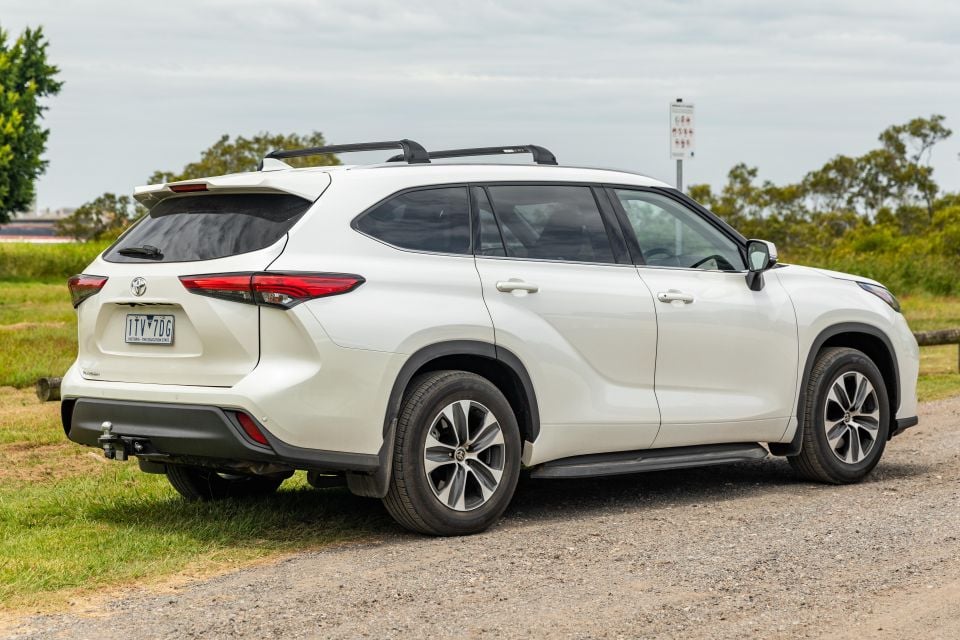

Quickly see how this car stacks up against its competition. Select any benchmark to see more details.
Where expert car reviews meet expert car buying – CarExpert gives you trusted advice, personalised service and real savings on your next new car.
Right now, no other brand can boast what Toyota offers in Australia: a large, body-on-frame SUV and a large, unibody crossover, both sitting atop the sales charts.
The Toyota Kluger is outsold by the more rugged LandCruiser Prado, but the brand is able to offer this one-two punch of two three-row SUVs.
If you want to tow heavier loads or go off-roading beyond a mere fire trail, you go for the Prado. If most of your driving is on pavement, you go for the Kluger.

While the Prado is over a decade old now, the Kluger was redesigned for 2021 (technically it entered production in 2019, Australia was just late getting it). What’s perhaps most surprising about the redesigned, fourth-generation Kluger is how much Toyota has made it look like the old one.
The exterior design is a fairly subtle evolution of that of the old car, while even the interior sticks to a familiar template. That’s despite the Kluger having moved to the TNGA architecture, leaving the venerable K platform behind.
The latest Kluger also offers the option of a hybrid in Australia at long last, even though such an option has been available elsewhere since the second-generation model.
Our tester isn’t a hybrid, however – it’s the good old-fashioned V6, more affordable to buy but less affordable to run.
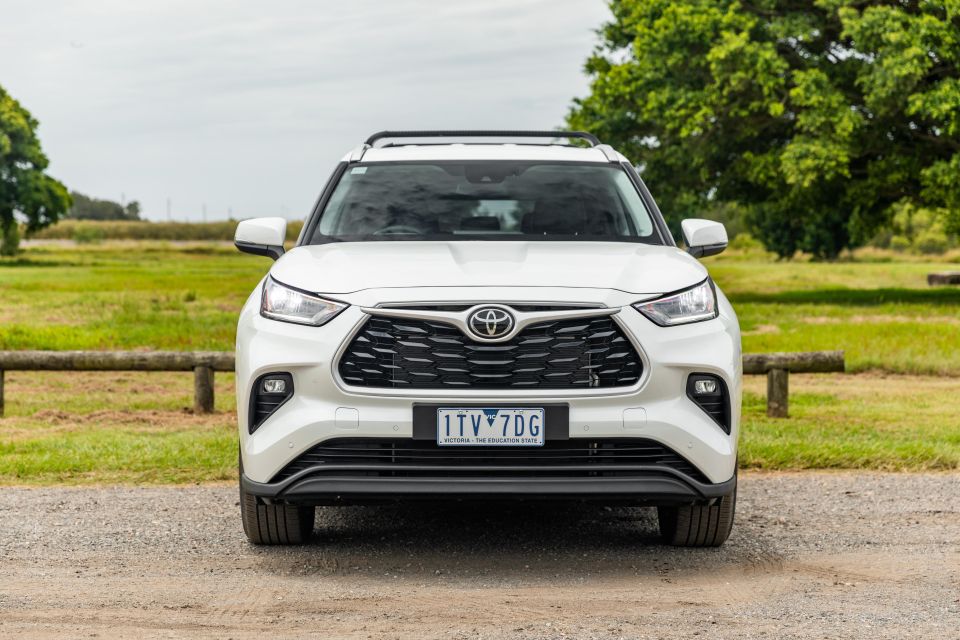
The Kluger range is large, but pretty simple: you can choose between three different trim levels, each with a choice of front-wheel drive V6, all-wheel drive V6, and all-wheel drive hybrid powertrains.
Our tester is the most affordable example of the mid-spec GXL, with front-wheel drive and a V6 engine. It’s priced at $57,150 before on-road costs. Add another $4000 for all-wheel drive, and a further $2500 to step up to the hybrid. Alternatively, you can spend $3000 less and get an all-wheel drive GX Hybrid.
Based on a Sydney postcode, you’re looking at $62,848 drive-away for the Kluger GXL 2WD V6.

Eclipse Black mica is the standard paint finish on the Kluger, with all other finishes – including our tester’s Crystal Pearl – costing an extra $675. The pearl white is handsome, though in some lights it looked like the bumpers were a different colour.
Our tester was also decked out with various accessories, including roof racks and illuminated side steps.
In terms of the competition, you can get a front-wheel drive Mazda CX-9 Touring for $53,590 before on-roads, or an all-wheel drive Touring for $57,590 list. A base Hyundai Palisade V6, which is available only with front-wheel drive, costs $55,700 before on-roads.
The smaller but still three-row Kia Sorento can be had in front-wheel drive Sport V6 FWD guise for $50,270 before on-roads and Sport+ V6 FWD guise for $54,850 list, while the Hyundai Santa Fe asks for $56,000 in front-wheel drive V6 Elite guise. Unlike the Toyota, these two Korean cousins – plus the Palisade – can also be had with all-wheel drive turbo-diesel drivetrains.

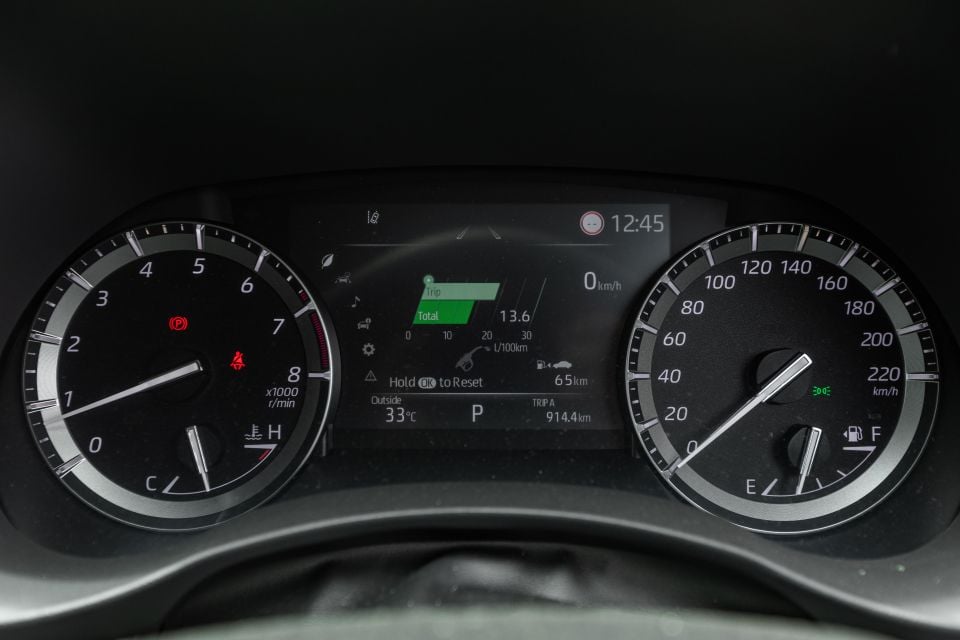
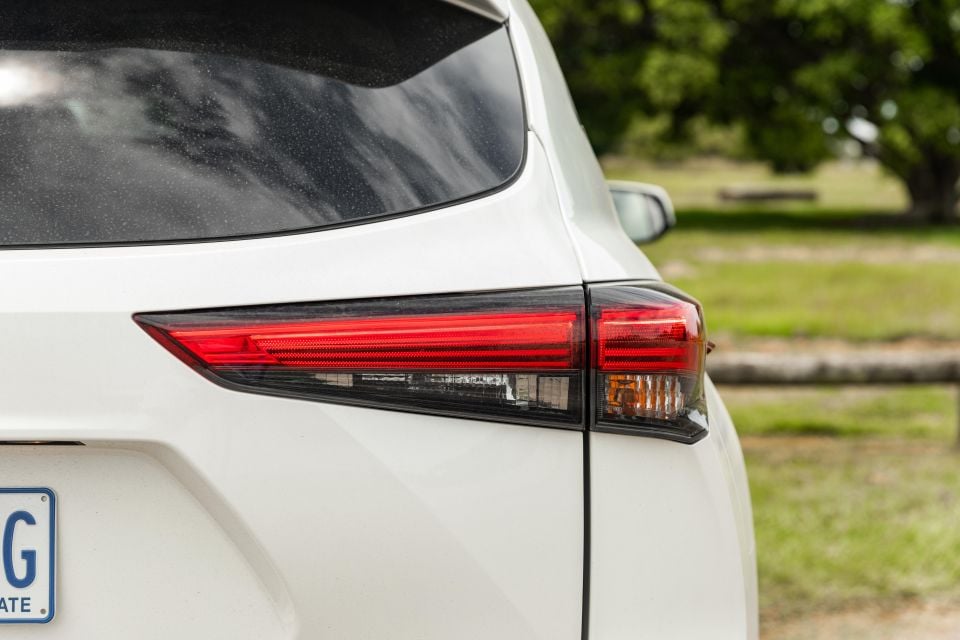
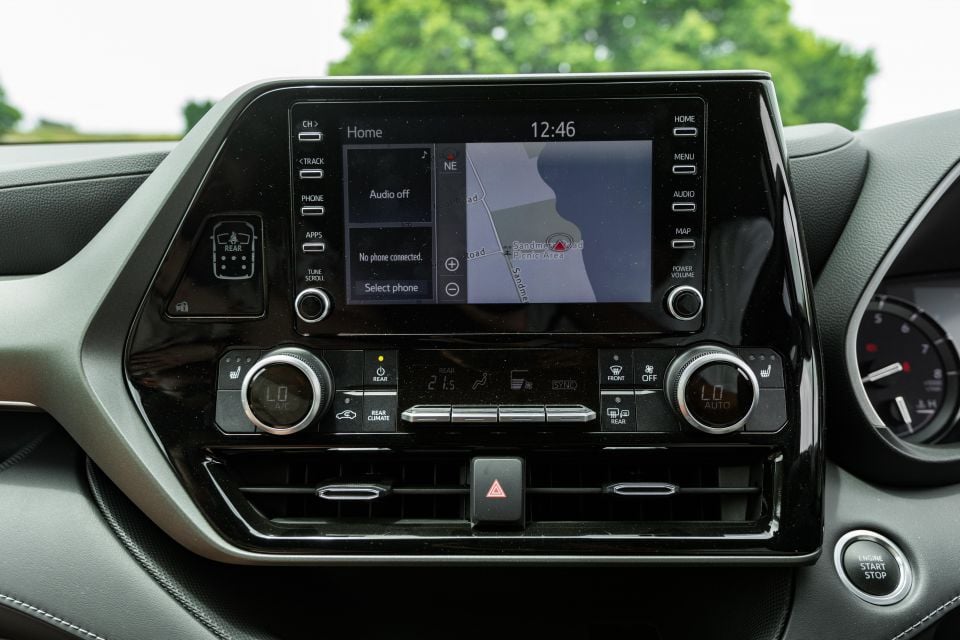
Buy your new car without the stress. It's fast, simple and completely free.

Great service from Travis and team, second time I have used this business would not hesitate to recommend them to anyone
Craig C.
Purchased a Ford Ranger in Sunshine Coast, QLD
CarExpert helped Craig save thousands on his Ford Ranger, now let us save you on your next new car.
Find a dealKluger GXL highlights:
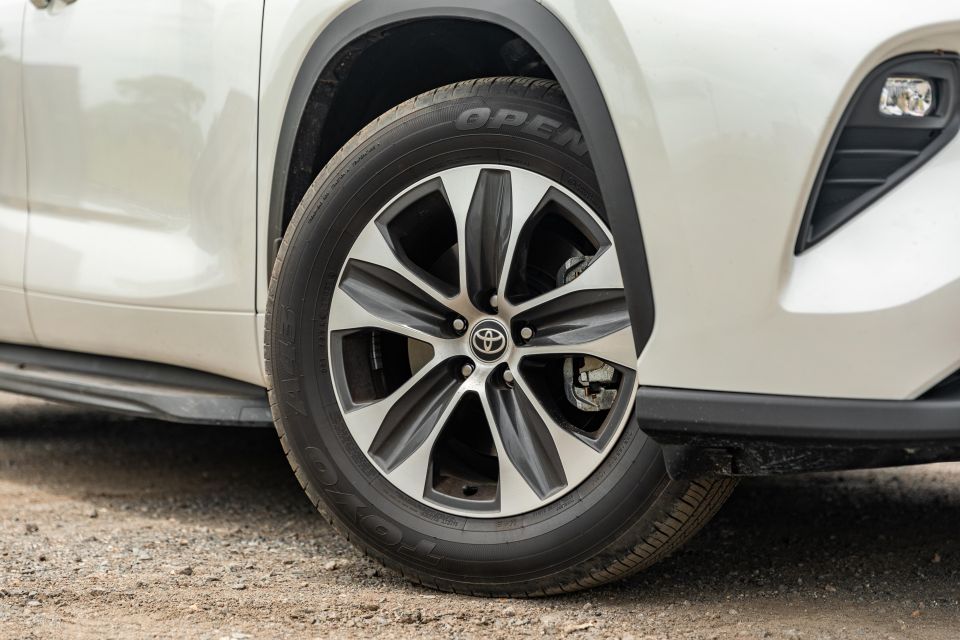
It also includes the following equipment found on the base GX:
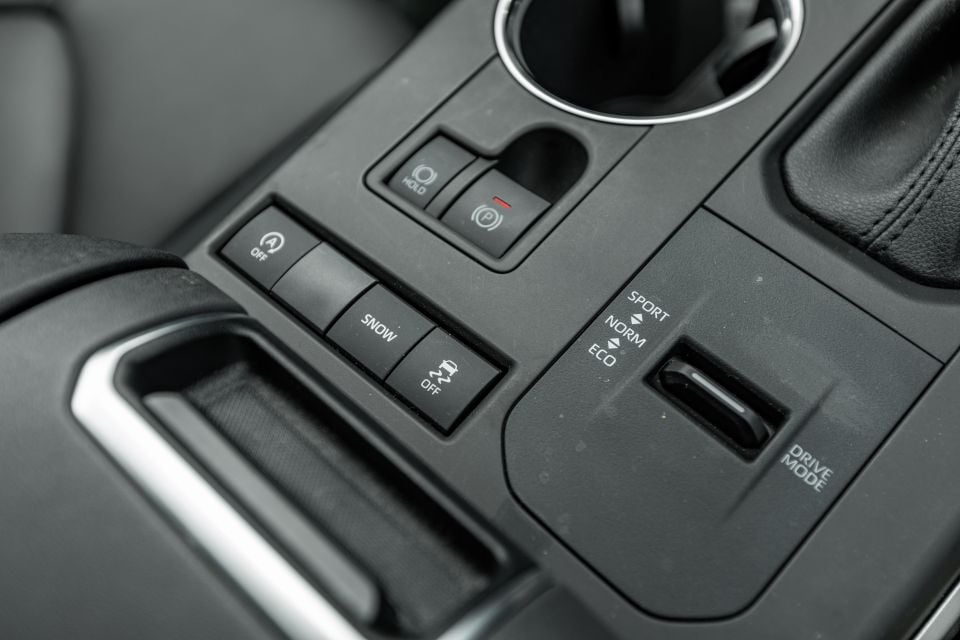
The top-spec Grande adds some useful equipment like a head-up display and surround-view cameras, but otherwise adds a raft of luxury features that aren’t strictly necessary like a panoramic sunroof and real leather upholstery.
The Kluger GXL doesn’t have the base Palisade’s wireless charging pad, but the Hyundai does without LED headlights and a power tailgate.
The Toyota lines up nicely with the Santa Fe Elite and Sorento Sport+ and, while it lacks the CX-9 Touring’s head-up display, it offers a power tailgate over the Mazda.

The Kluger has a five-star ANCAP safety rating based on testing conducted in 2021.
It received scores of 90 per cent for adult occupant protection, 88 per cent for child occupant protection, 76 per cent for vulnerable road user protection, and 82 per cent for safety assist.
Standard safety equipment includes:
That’s a comprehensive safety suite. The Santa Fe and Sorento feature active blind-spot and rear cross-traffic assists plus a front-centre airbag, though they don’t have full curtain airbag coverage for the third row.
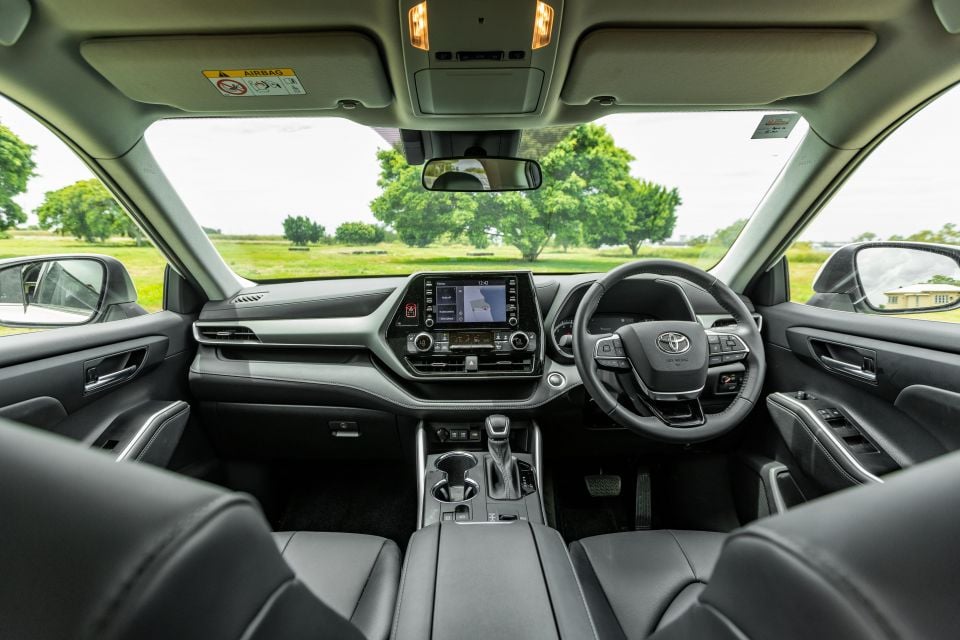
The Toyota Kluger mightn’t have the glitziest or most attractive interior in the segment, but it’s well-built and logically laid-out.
Its dash looks newer than the CX-9’s, though you could argue it doesn’t look quite as upmarket. The Palisade has it beat for showroom appeal while also boasting great usability, while the Santa Fe, Sorento and upcoming Nissan Pathfinder feature more cohesive, symmetrical designs.
While the dashboard design is quite fussy, this has some upsides. There are big cutouts on both the passenger side and under the centre stack which have a grippy material in them, making them a practical – if uncovered – location for your items. You’ll also find a grippy material within the ceiling-mounted sunglass holder.
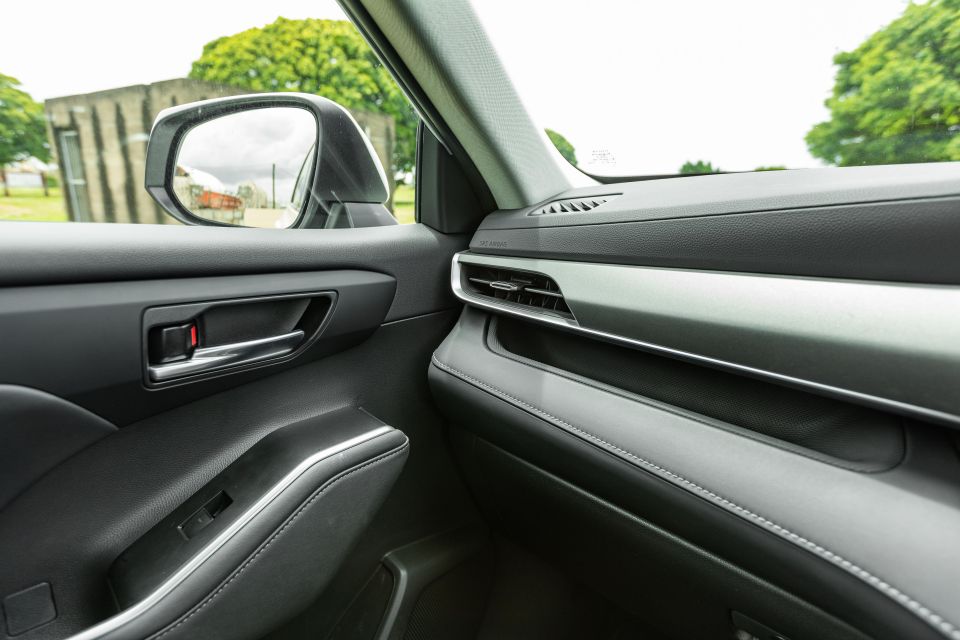
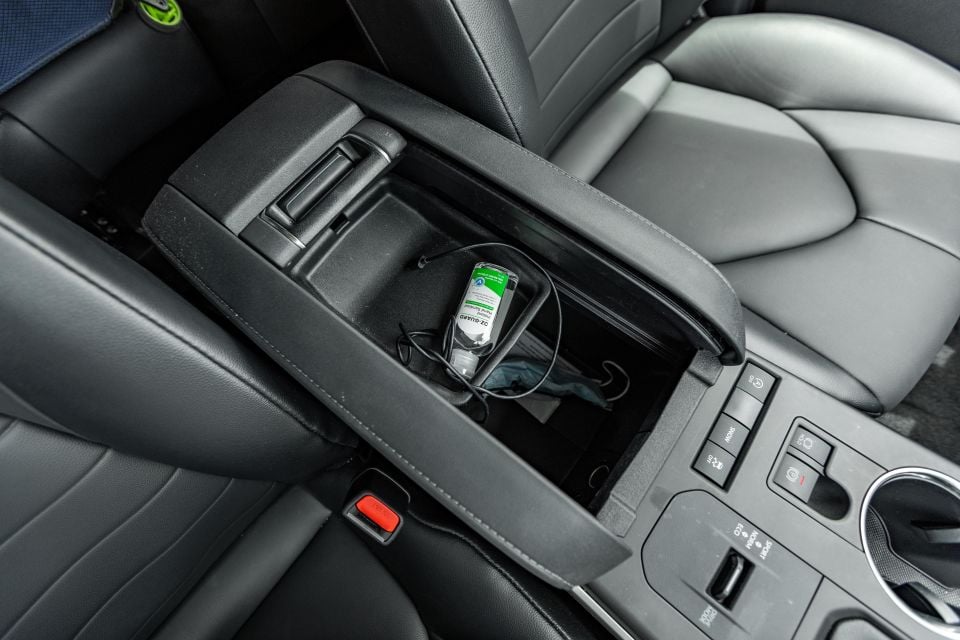
Storage in the cabin is quite good, with a deep centre console bin with a roll-top lid, bottle holders in the doors that can fit a 1L bottle, and a little cubby to the right-hand side of the steering wheel.
There’s plenty of piano black trim, but it’s at least limited to surfaces you’re unlikely to touch. For example, there’s very little of it on the centre console.
The physical climate controls are easy to find and easy to use, though they’re situated on a gloss black monolith that juts out from the dashboard.
The touchscreen is a rather average 8.0-inch unit – sadly, the 12.3-inch available in the US isn’t offered in Australia, even in the flagship Grande.


There are helpful physical shortcut buttons flanking it, but it’s the same system you’ll find throughout the Toyota line-up, with all its pros (acceptable response times, wired smartphone mirroring) but all its cons (washed-out, dreary graphics).
Like the flagship Grande, the GXL uses a larger 7.0-inch (instead of 4.2-inch) screen within the instrument cluster. It’s crisp and, helpfully, the time and your speed limit is always visible regardless of the screen you select.
At the base of the centre stack you’ll find three USB outlets plus a 12V outlet, however there’s no wireless charging pad despite there seemingly being a space for one. You can get one in overseas models, however it’s not available here, even in the Grande.
The front seats are cushy and relatively supportive, while the leatherette doesn’t feel too bad.
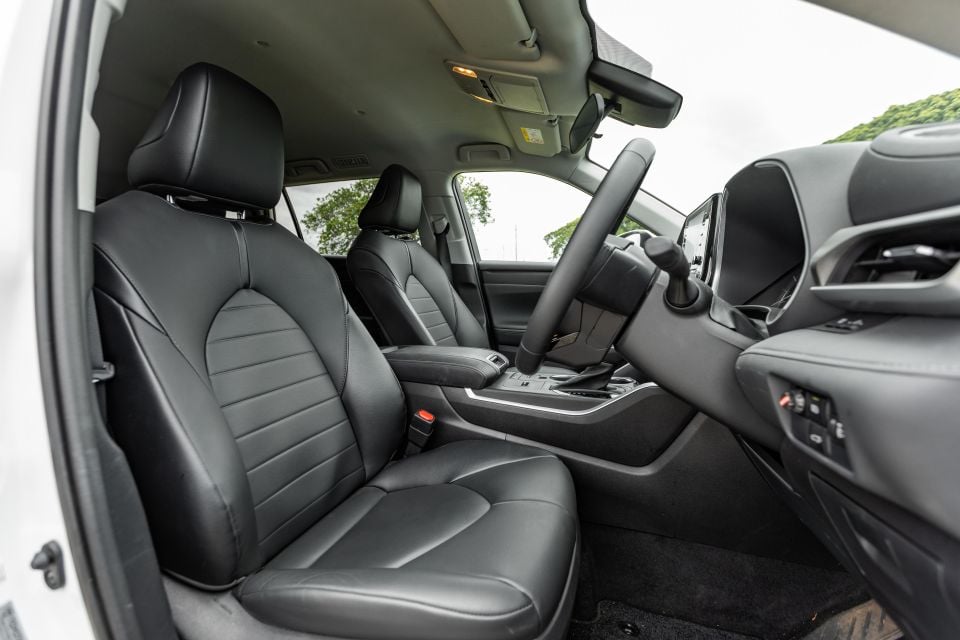
The only interior colour option is black in the GX and GXL, though if you step up to the Grande you can also choose Harvest Beige. Sadly, Australia misses out on the racy red interior available elsewhere, as well as the delicious Glazed Caramel.
You’ll find soft-touch plastic or leatherette on most of the dashboard except, strangely, the instrument cluster hood. There’s also hard plastic on the lower reaches of the dash and front doors, while the rear doors lack the soft-touch tops of the front doors though retain leatherette inserts.
More frustrating is the lack of soft-touch trim on the sides of the centre console where you might rest your knees, though this can be found on the Kluger Grande.
While the interior feels solidly screwed together and a noticeable step up from the last Kluger, there are some cheap, unpleasant elements.
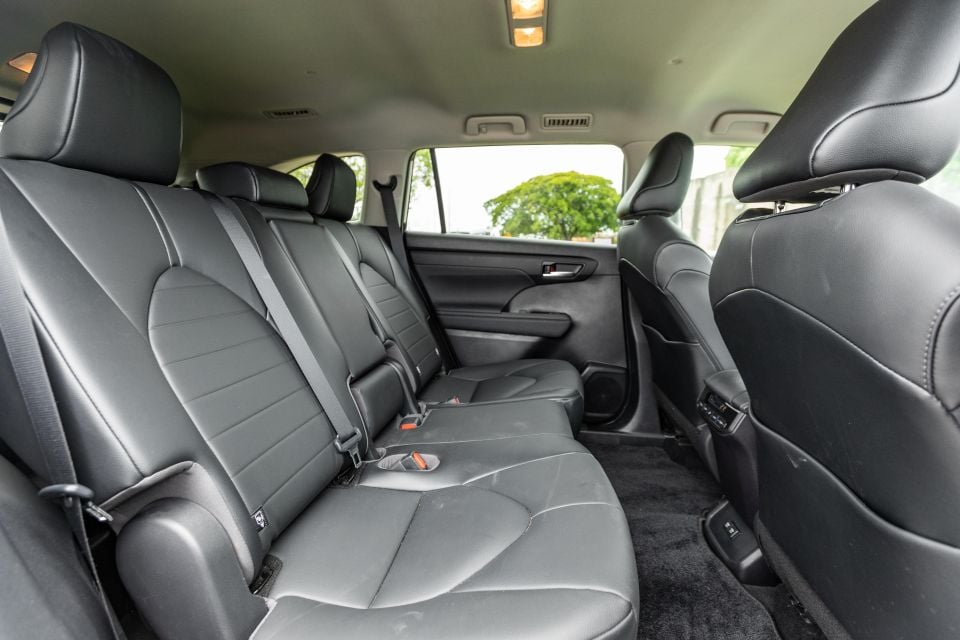
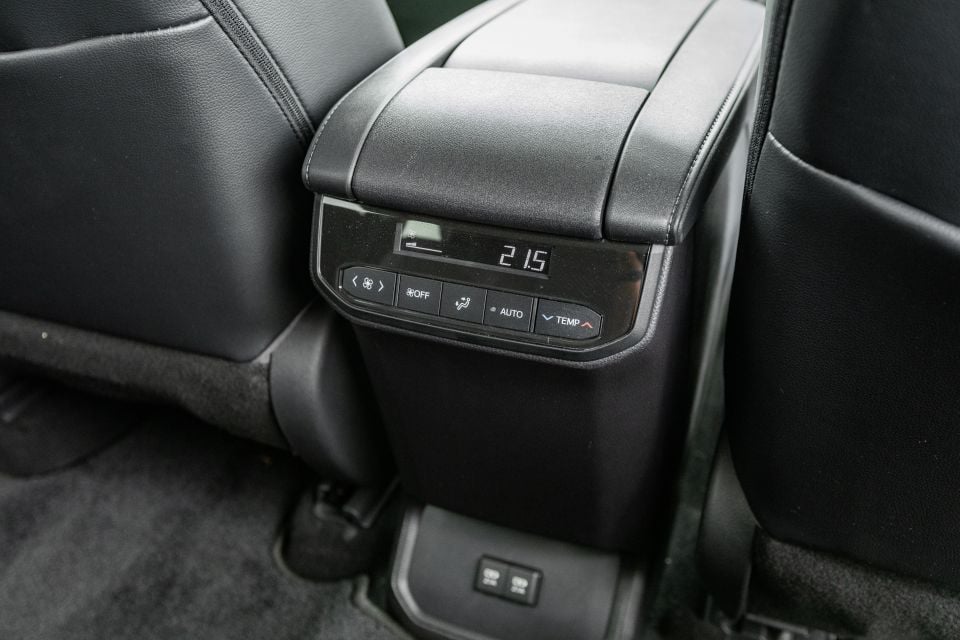
The shifter feels cheap and plasticky, for example, while at the base of the steering wheel there’s a scratchy plastic box that has too much give.
Overall, however, a feeling of quality pervades the interior, from well-damped switchgear to doors that close with a solid thunk. We observed only a single rattle, a faint one emanating from the passenger side and only on coarse-chip roads.
Step into the second row and there’s ample headroom, leg room and knee room. I’m 180cm tall and I can comfortably sit behind my driving position with plenty of room to spare.
The middle seat is firmer and sits slightly higher but there’s only a minimal hump on the floor, so it’s hospitable.
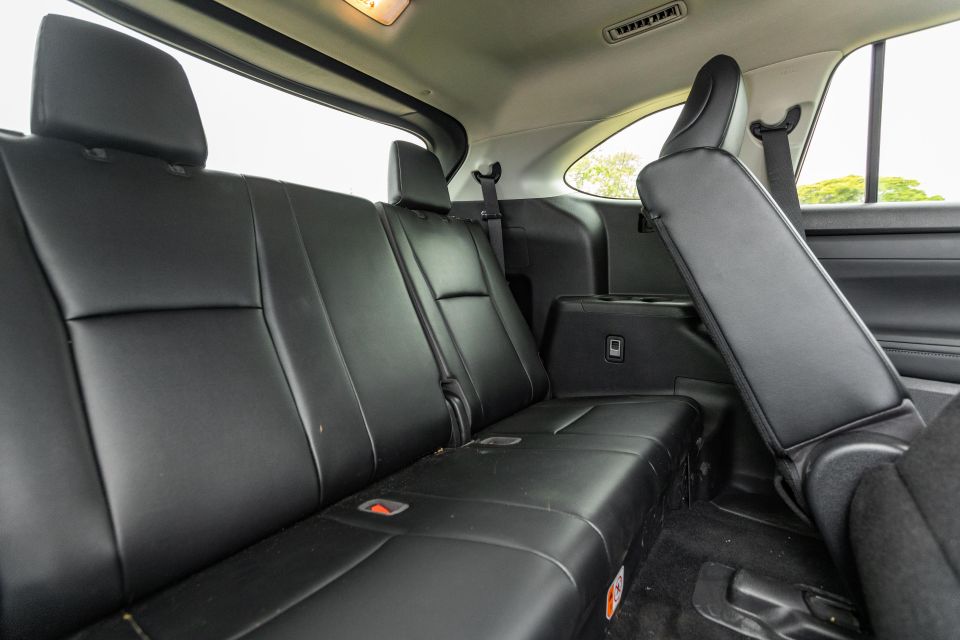

Where expert car reviews meet expert car buying – CarExpert gives you trusted advice, personalised service and real savings on your next new car.
There are three top-tether points for child seats in the second row, as well as ISOFIX attachment points on the outboard seats.
You can slide the second row seats to free up room for the third row, and I can technically sit behind the second row when it’s at its rearmost position. Note I said technically, not comfortably.
It’s awkward clambering back here, and the roof fares in at the sides to accommodate the air vents. That makes it feel rather constricted back here, and my hair was touching the roof. Still, headroom feels better than a CX-9, though leg room feels worse.


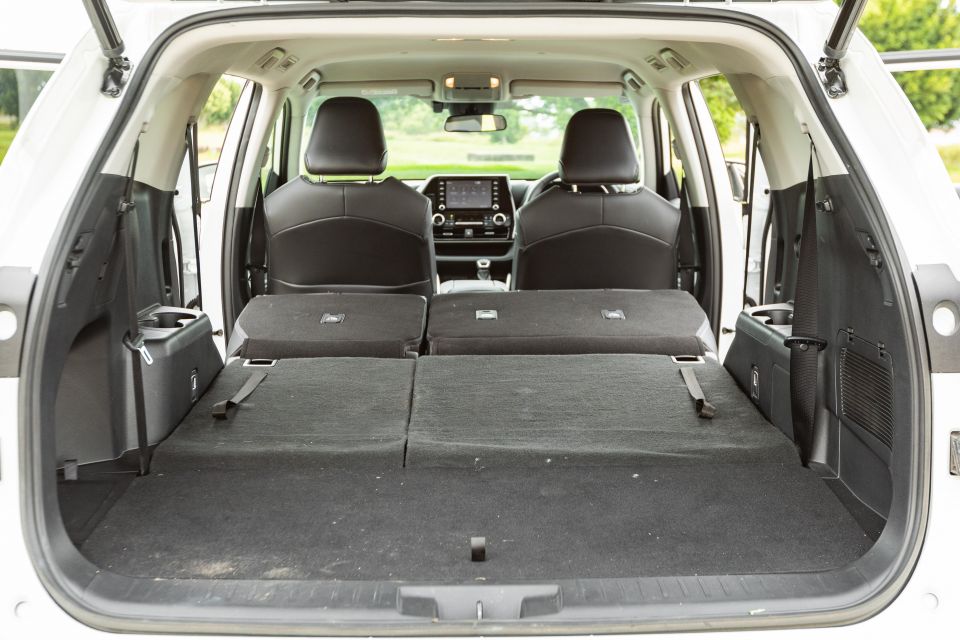
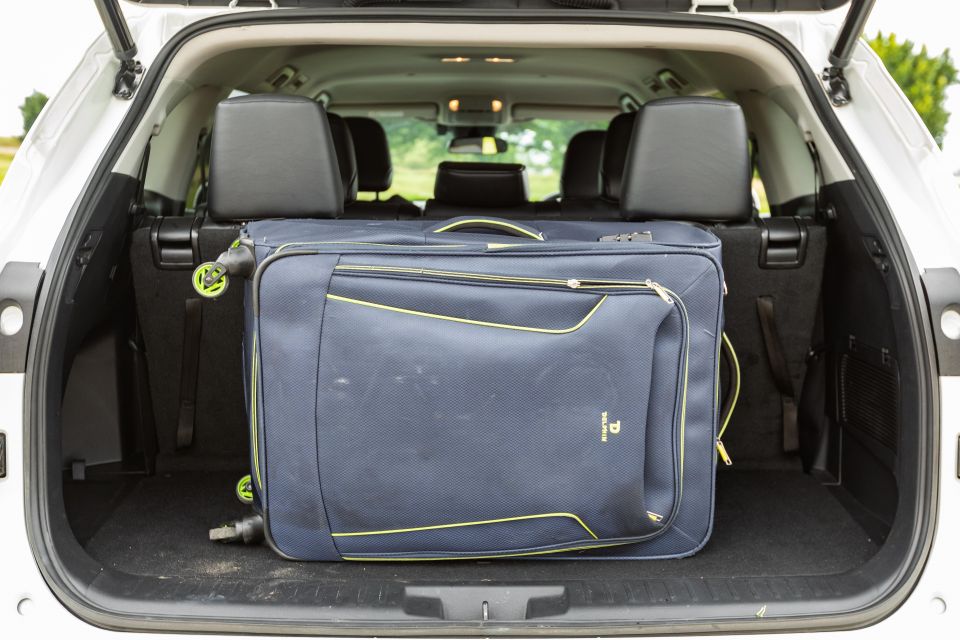
Both the Kluger and CX-9 feel smaller back here, however, than the equally US-focused Palisade. Ultimately, however, these seats are most likely to be for occasional use, and likely by children.
There are still cupholders and, as mentioned, vents back here, though there are no power or USB outlets. You also won’t find any top-tether or ISOFIX anchor points for child seats like you will in a Kia Sorento.
There’s 241L of luggage space with all three rows up, 552L with the third row folded, and 1150L with the third and second rows folded.
For reference, Mazda quotes 230L for the curvier CX-9 with all three rows erect and 810L with the third row dropped, while the Palisade has 311L with all rows up and 704L with the rearmost row folded.
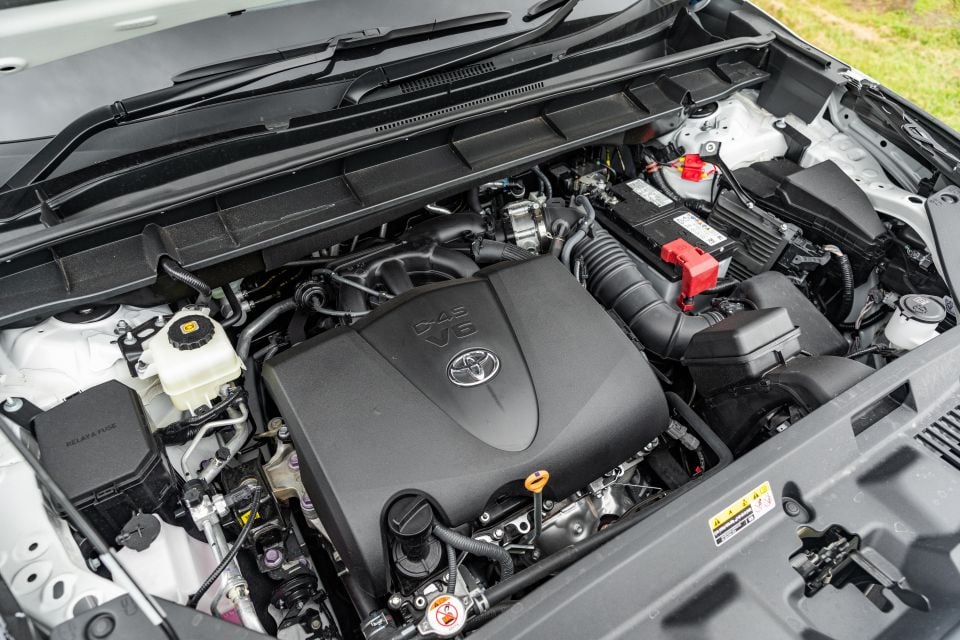
The Kluger offers a choice of two powertrains. The standard engine – and the only one available in Australia with front-wheel drive – is a naturally-aspirated 3.5-litre petrol V6 producing 218kW of power and 350Nm of torque.
It’s mated to an eight-speed automatic transmission and, unlike rivals like the Hyundai Santa Fe and Palisade, it can also be had with all-wheel drive. Our tester was front-wheel drive.
All V6 models feature an idle stop/start system.
The V6’s power output is above that of the pricier hybrid, which has a total system output of 184kW; Toyota doesn’t quote a combined torque figure.

Toyota claims 8.7L/100km on the combined cycle in front-wheel drive guise, or 8.8L/100km with all-wheel drive. The V6 will happily run on 91 RON regular unleaded fuel, while the hybrid requires more expensive 95RON.
We averaged 11L/100km on a loop consisting of a mix of inner-city, suburban and highway driving. This increased to 12.2L/100km over the course of a week with the Kluger, albeit with a skew towards urban driving.
Over an identical loop in an all-wheel drive, Grande Hybrid, we averaged 5.9L/100km, and saw this increase to only 7.4L/100km over the course of a week. But against rival petrol-powered models, the V6 Kluger fares better – with a Palisade V6, for example, we recorded a loop figure of 10.8L/100km, increasing to 11.5L/100km over the course of a week.
Braked towing capacity in the Kluger is 2000kg, regardless of whether you choose front- or all-wheel drive or V6 or hybrid powertrains.
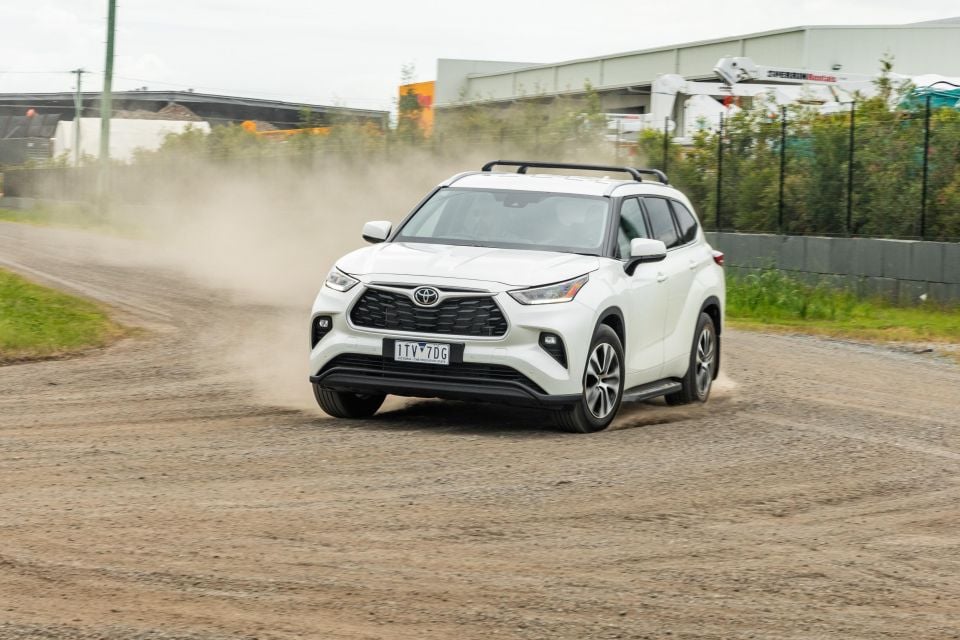
The Kluger has a nice, substantial feel to it. Perhaps a little too substantial, given you have to work the V6 a bit even with a single person in the car.
For those used to naturally-aspirated V6 engines, the power delivery and sound will be comfortably familiar, but so will the high fuel consumption.
The engine winds out in classic V6 fashion, with peak torque coming at 4700rpm. It never feels terribly fast, and a turbocharged four-cylinder would in theory yield better low-end response – just look at the Mazda CX-9, where peak torque comes in at 2000rpm.
In day-to-day driving, the Kluger Hybrid doesn’t really feel any slower despite the extra weight of the hybrid system and all-wheel drive, even though it sounds slower due to its uninspiring engine note.
The V6 has a pleasant engine note and never sounds too coarse, while the cabin is generally quite quiet – wind noise at highway speeds is limited, though there’s a bit of tyre roar on coarse-chip roads.
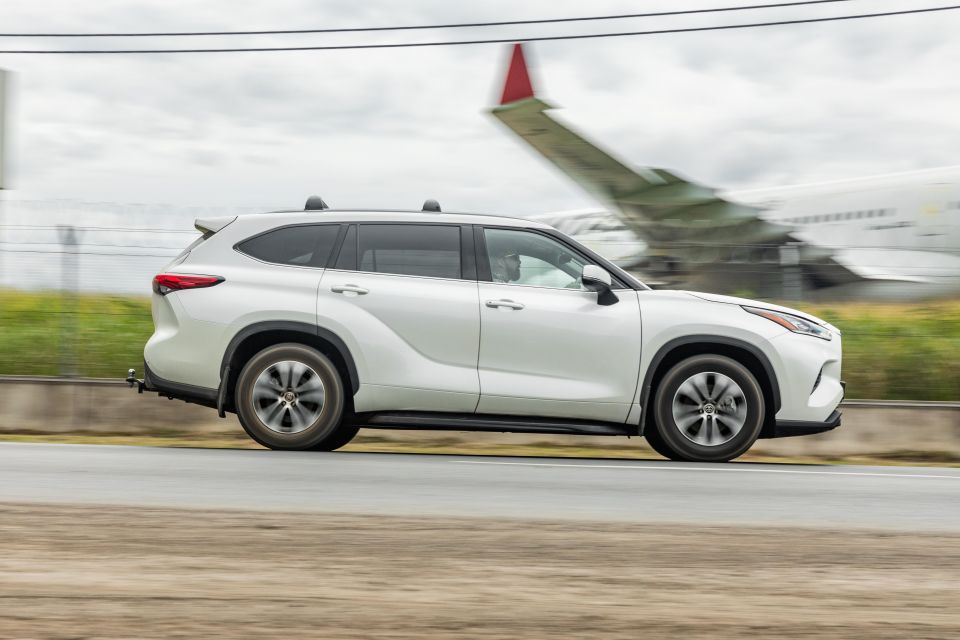
Like the now-defunct Camry V6, Toyota engineers have done a good job managing torque steer. That’s something that used to afflict V6 Klugers, but you can take off cleanly in the new model.
The latest generation of TNGA-based Toyotas have all felt much more dynamically resolved than their predecessors, and that includes the Kluger.
Despite its soft ride, the Kluger doesn’t embarrass itself when the roads get more windy. It’s technically proficient, with body roll well controlled for such a large crossover.
Likewise on undulating country roads, it boasts good body control and avoids feeling floaty.
There’s little in the way of road feel with the steering, but its well-judged weighting means it’s light enough to make urban manoeuvring easy without feeling overly loose and disconnected, while still inspiring confidence at higher speeds.

You can toggle between Eco, Normal and Sport modes, but there’s not a considerable difference in feel between the latter two.
The well-weighted steering helps make the Kluger feel more confident than a Palisade, if not quite as dynamic as a CX-9. It does get power to the ground better than the front-wheel drive CX-9, however.
Where the Kluger thrives is out on the open road or. The cabin is quiet and the ride is soft and loping without feeling nautical.
It’ll easily gobble up the miles, soaking up bumps and ruts in the road.
There’s an impressive, fuss-free manner in which the Kluger conducts itself. The transmission shifts smoothly if not quite imperceptibly, handling is neutral and secure, and ride quality is excellent.
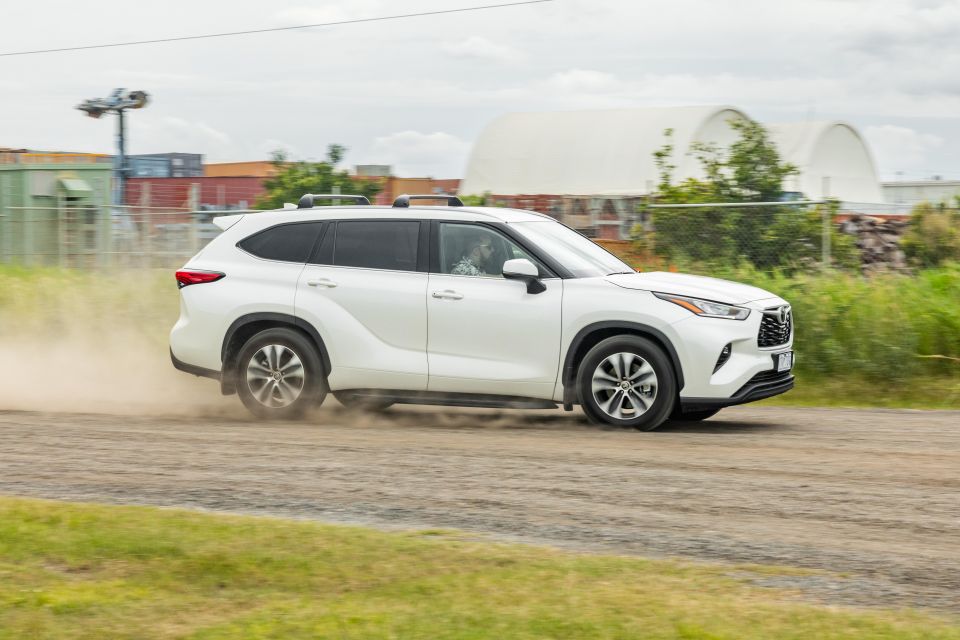
You have to press the brake firmly in the Kluger for the idle stop/start to activate, upon which a timer will appear in the instrument cluster displaying how long it’s been active for.
The active safety and driver assist technologies can be a mixed bag.
The traffic sign recognition works well, and it’s great to simply press a single button while the adaptive cruise is active to adjust your speed to changing speed limits.
The adaptive cruise control sometimes struggled to keep the vehicle at the set speed on downhill stretches though, and the overspeed alert would then start beeping.
On a couple of occasions, Lane Trace Assist didn’t keep the car adequately centred in its lane, resulting in a series of beeps (from the car, fortunately, not from other drivers).
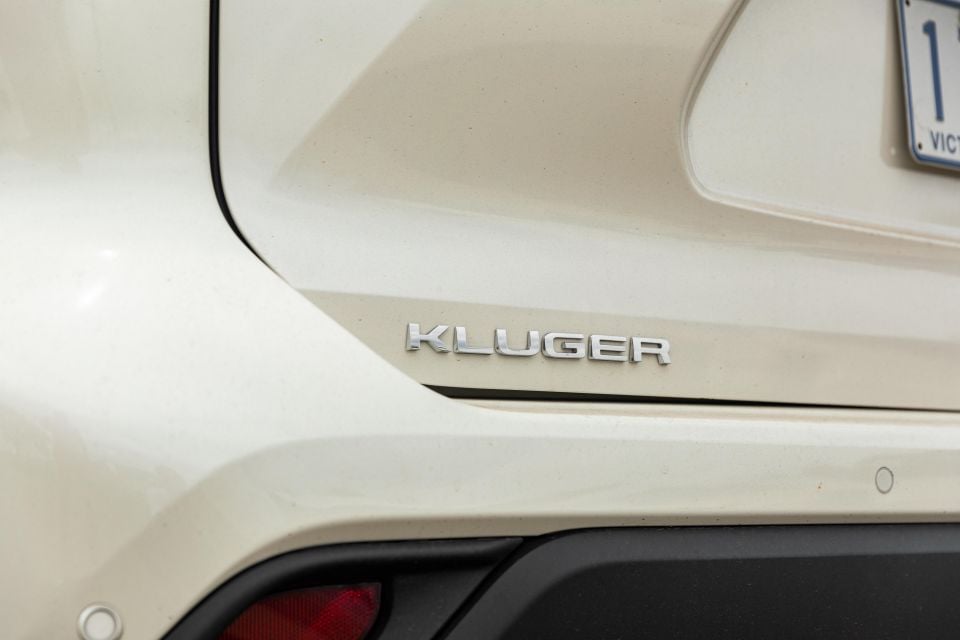
The Kluger is covered by a five-year, unlimited-kilometre warranty.
Toyota also offers five years of capped-price servicing, with each service – due every 12 months or 15,000km – costing $250.
The hybrid version has the same servicing intervals and servicing costs. Said prices are cheaper than all the Kluger’s rivals.
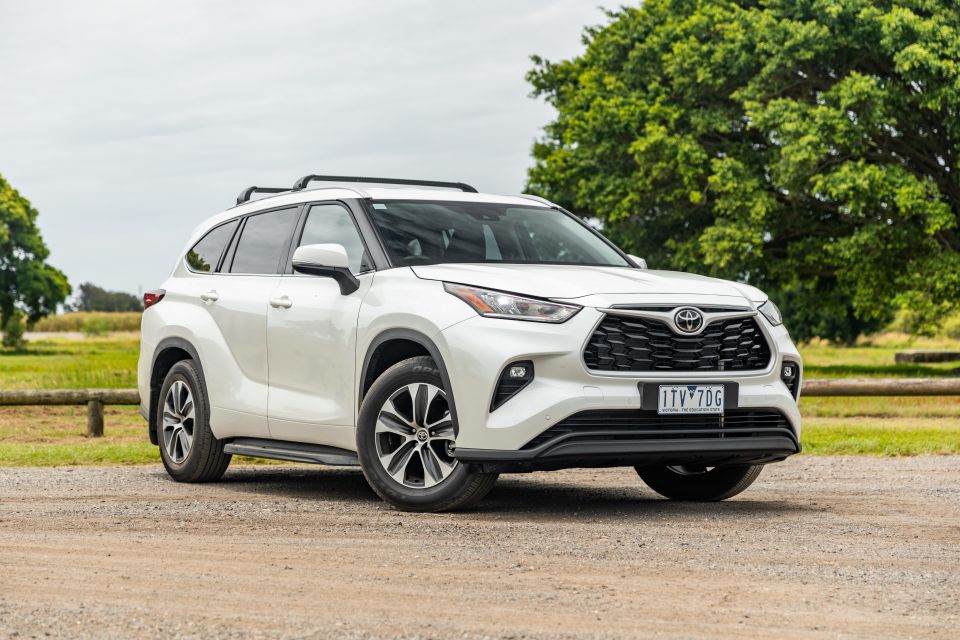
The Kluger V6 is a thoroughly cushy, comfortable car to drive, and there’s a nice old-school feel to its loping ride and V6.
Its hybrid counterpart is considerably more efficient, but if you don’t require all-wheel drive the price gulf widens from a reasonable $2500 to a steeper $6500 that’s much harder to justify. The front-wheel drive GXL V6, therefore, represents solid value for money.
It faces some tough competition, however. It feels more substantial to drive than a Hyundai Palisade, but the Korean SUV has a more appealing and more spacious interior with a better third row, while there’s also the stalwart Mazda CX-9 plus the smaller – but still spacious – Hyundai Santa Fe and Kia Sorento.
As an overall package, the Kluger GXL V6 mightn’t be flashy but it’s well-priced, well-sized and well-appointed. Throw in Toyota’s affordable servicing and expansive dealership network and it’s easy to see why the Kluger remains one of Australia’s most popular SUVs.

Click the images for the full gallery
MORE: Everything Toyota Kluger
Where expert car reviews meet expert car buying – CarExpert gives you trusted advice, personalised service and real savings on your next new car.
William Stopford is an automotive journalist with a passion for mainstream cars, automotive history and overseas auto markets.


Matt Campbell
2 Hours Ago


William Stopford
18 Hours Ago


CarExpert.com.au
4 Days Ago


Max Davies
5 Days Ago


Damion Smy
6 Days Ago


Max Davies
6 Days Ago